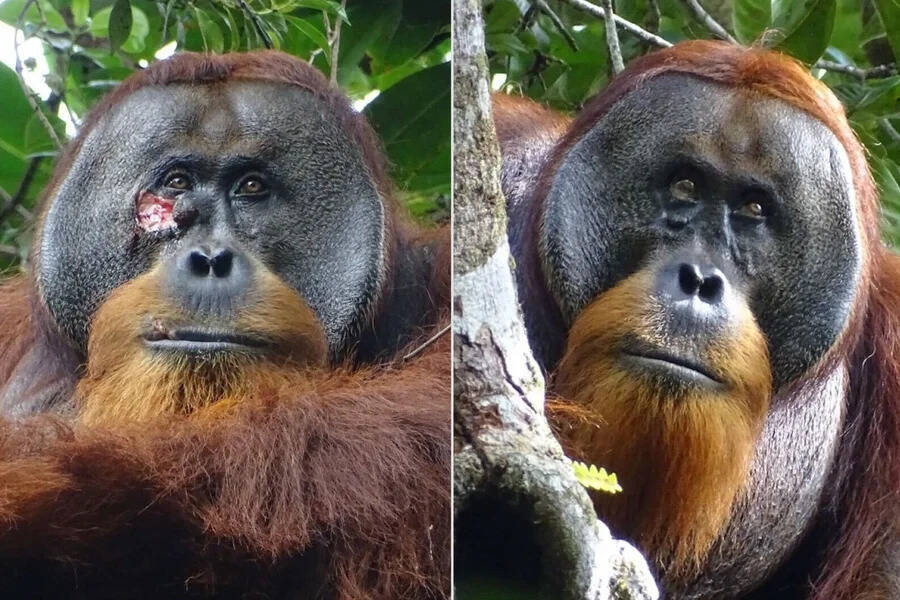Rakus, an adult male orangutan, was observed by researchers in Indonesia applying potent medicinal plants to an open wound — a behavior that has never been seen in a nonhuman animal before.

Armas (left) and Safruddin (right)/Max Planck Institute of Animal BehaviorRakus the orangutan photographed with a facial wound on June 23, 2022 (left) and again on Aug. 5, 2022 (right).
Researchers studying orangutans at the Gunung Leuser National Park in Indonesia recently observed an incredible behavior in an orangutan named Rakus. The adult male, injured during a suspected fight with another male, selected a plant known for its potent medicinal properties and applied it to his open face wound.
This behavior, never before seen in any non-human animal, has posed new questions about the intelligence of orangutans and the evolution of wound care in humans.
Rakus The Orangutan Uses Medicinal Plants
In 2022, Ulil Azhari, a study co-author and field researcher at the Suaq Project in Medan, Indonesia, was observing orangutans in Gunung Leuser National Park when he witnessed something incredible.
An adult male orangutan named Rakus had a face wound he’d presumably sustained during a fight with another animal. Azhari watched in astonishment as Rakus plucked and chewed the leaves of the Fibraurea tinctoria, a type of liana climbing vine known for its antibacterial, anti-inflammatory, anti-fungal, and pain-killing properties — and spread them onto his wound.
“Thirteen minutes after Rakus had started feeding on the liana, he began chewing the leaves without swallowing them and using his fingers to apply the plant juice from his mouth directly onto his facial wound,” the researchers wrote in their study of the phenomenon.
“He then continued jewing without swallowing and repeatedly applied plant sap precisely onto the wound on his right flange for seven minutes. As a last step he then covered the entire wound with solid chewed plant material, like a wound plaster. He then continues feeding on the plant for half an hour and on the next day,” Isabelle Laumer, lead author of the study, told All That’s Interesting in an email.
Researchers found Rakus five days later and were pleasantly surprised that his wound had closed. A few weeks later, Rakus’ wound had completely healed.
And while researchers believe that Rakus used the plant intentionally, they are unsure how much of the process he comprehends.
“It shows that he, to some extent, has the cognitive capacities that he needs to treat the wound with some medically active plants,” Dr. Caroline Schuppli, senior author of the study and a researcher at the Max Planck Institute of Animal Behavior in Germany, told The Guardian. “But we really don’t know how much he understands.”
Wound Care And The Evolution Of Humans

Saidi Agam/Suaq Project/PAThe Fibraurea tinctoria – a type of liana climbing vine known for its medicinal properties.
Rakus’ demonstration is not the first time an animal has been observed using plants for medicinal purposes.
Researchers have observed Bornean orangutans rubbing their limbs with chewed-up leaves from a plant humans commonly use to treat sore muscles. Additionally, scientists have documented chimpanzees chewing plants known to treat worm infections and even applying insects to wounds.
However, Rakus’ case is unique in that it is the first time researchers have observed an animal applying a substance known to have potent medicinal properties to an open wound.
“In the chimpanzee case they used insects and unfortunately it was never found out whether these insects really promote wound healing,” Schuppli told The Guardian. “Whereas in our case, the orangutan used the plant, and this plant has known medical properties.”
While researchers are unsure if Rakus learned this behavior on his own or from other orangutans, it reveals interesting information about the evolution of wound care, even in humans.
“It is possible that there exists a common underlying mechanism for the recognition and application of substances with medical or functional properties to wounds and that our last common ancestor already showed similar forms of ointment behavior,” Laumer told All That’s Interesting.
“If this behavior exists in some of our closest living relatives, what could that tell us about how medicine first evolved?” Tara Stoinski, president and chief scientific officer for the nonprofit Dian Fossey Gorilla Fund, told the Associated Press.
After reading about the orangutan who used medicinal plants, dive into the story of the Orang Pendek, the ‘Bigfoot’ of Sumatra. Then, read about 11 of the weirdest animals on Earth.





